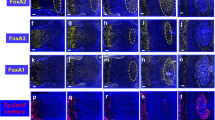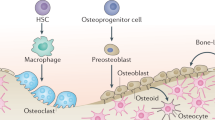Abstract
The mouse fetal metatarsal provides a unique tool for studying angiogenesis. In comparison with other commonly used in vitro or ex vivo angiogenesis assays, vessel outgrowth from mouse fetal metatarsals is more representative of sprouting angiogensis in vivo. It allows the analysis of blood vessel growth, and the mechanisms underpinning this process, in a multicellular microenvironment that drives the formation of a robust and complex vascular network in the absence of exogenous growth factors. By labeling different constituents of the vascular structure, it is possible to perform 3D rendering of the spatial interplay between different cellular components and to carry out quantitative analysis of vessel outgrowth. High-resolution imaging permits the visualization of fine structural and cellular details. As the assay involves the use of fetal tissues, it is possible to follow new blood vessel formation in genetically modified mice that are perinatally lethal. The entire process takes 9–13 d. A detailed description of how to set up and perform the assay is described here.
This is a preview of subscription content, access via your institution
Access options
Subscribe to this journal
Receive 12 print issues and online access
$259.00 per year
only $21.58 per issue
Buy this article
- Purchase on Springer Link
- Instant access to full article PDF
Prices may be subject to local taxes which are calculated during checkout










Similar content being viewed by others
References
Deckers, M. et al. Effect of angiogenic and antiangiogenic compounds on the outgrowth of capillary structures from fetal mouse bone explants. Lab. Invest. 81, 5–15 (2001).
Baker, M. et al. Use of the mouse aortic ring assay to study angiogenesis. Nat. Protoc. 7, 89–104 (2012).
Wang, X. et al. LRG1 promotes angiogenesis by modulating endothelial TGF-β signalling. Nature 499, 306–311 (2013).
Snoeks, T.J., Mol, I.M., Que, I., Kaijzel, E.L. & Lowik, C.W. 2-methoxyestradiol analogue ENMD-1198 reduces breast cancer-induced osteolysis and tumor burden both in vitro and in vivo. Mol. Cancer Ther. 10, 874–882 (2011).
van der Pluijm, G. et al. In vitro and in vivo endochondral bone formation models allow identification of anti-angiogenic compounds. Am. J. Pathol. 163, 157–163 (2003).
Liu, Z. et al. VEGF and inhibitors of TGF-β type-I receptor kinase synergistically promote blood-vessel formation by inducing α5-integrin expression. J. Cell Sci. 122, 3294–3302 (2009).
van Wijngaarden, J. et al. An in vitro model that can distinguish between effects on angiogenesis and on established vasculature: actions of TNP-470, marimastat and the tubulin-binding agent Ang-510. Biochem. Biophys. Res. Commun. 391, 1161–1165 (2010).
Leenders, W. et al. Design of a variant of vascular endothelial growth factor-A (VEGF-A) antagonizing KDR/Flk-1 and Flt-1. Lab. Invest. 82, 473–481 (2002).
Liu, Z. et al. ENDOGLIN is dispensable for vasculogenesis, but required for vascular endothelial growth factor-induced angiogenesis. PLoS ONE 9, e8627 (2014).
Cackowski, F.C. et al. Osteoclasts are important for bone angiogenesis. Blood 115, 140–149 (2010).
Wan, L., Zhang, F., He, Q., Tsang, W.P. & Lu, L. EPO promotes bone repair through enhanced cartilaginous callus formation and angiogenesis. PLoS ONE 9, e102010 (2014).
Chim, S.M. et al. EGFL7 is expressed in bone microenvironment and promotes angiogenesis via ERK, STAT3, and integrin signaling cascades. J. Cell Physiol. 230, 82–94 (2015).
Zhu, K. et al. ATF4 promotes bone angiogenesis by increasing VEGF expression and release in the bone environment. J. Bone Miner. Res. 28, 1870–1884 (2013).
Sun, H.L., Jung, Y.H., Shiozawa, Y., Taichman, R.S. & Krebsbach, P.H. Erythropoietin modulates the structure of bone morphogenetic protein 2-engineered cranial bone. Tissue Eng. Part A 18, 2095–2105 (2012).
Shao, Z. et al. Choroid sprouting assay: an ex vivo model of microvascular angiogenesis. PLoS ONE 8, e69552 (2013).
Cooke, V.G. et al. Pericyte depletion results in hypoxia-associated epithelial-to-mesenchymal transition and metastasis mediated by met signaling pathway. Cancer Cell 21, 66–81 (2012).
Goren, I. et al. A transgenic mouse model of inducible macrophage depletion: effects of diphtheria toxin-driven lysozyme M-specific cell lineage ablation on wound inflammatory, angiogenic, and contractive processes. Am. J. Pathol. 175, 132–147 (2009).
Lindblom, P. et al. Endothelial PDGF-B retention is required for proper investment of pericytes in the microvessel wall. Gene Dev. 17, 1835–1840 (2003).
Abramsson, A., Lindblom, P. & Betsholtz, C. Endothelial and nonendothelial sources of PDGF-B regulate pericyte recruitment and influence vascular pattern formation in tumors. J. Clin. Invest. 112, 1142–1151 (2003).
Yen, M.L. et al. Diosgenin induces hypoxia-inducible factor-1 activation and angiogenesis through estrogen receptor-related phosphatidylinositol 3-kinase/Akt and p38 mitogen-activated protein kinase pathways in osteoblasts. Mol. Pharmacol. 68, 1061–1073 (2005).
Acknowledgements
We thank D.L. Becker and L.E. Madden for their expertise in confocal microscopy. We thank S. Chai for his help with the Imaris software. This work was sponsored by grants from the Singapore Ministry of Education Academic Research Fund Tier 1 (2013-T1-002-051) and the ingapore Ministry of Education Academic Research Fund Tier 2 (MOE2014-T2-1-036) to X.W., by a National Medical Research Council—Cooperative Basic Research Grant (CBRG13nov094) to X.W. and W.H., and by a Medical Research Council UK grant (002973) awarded to J.G., S.E.M. and X.W.
Author information
Authors and Affiliations
Contributions
H.S. and X.W. optimized the protocol and designed the experiment. W.S., C.W.F., K.H.A., C.H.L., N.A.B.J., D.L., S.A. and X.W. performed the experiment. All authors contributed to the figure and manuscript preparation.
Corresponding author
Ethics declarations
Competing interests
The authors declare no competing financial interests.
Integrated supplementary information
Supplementary Figure 1 Comparison of vessel outgrowth between metatarsals and metacarpals.
Vessel outgrowths are labeled by PECAM-1 7 days after seeding. The total vascular area is normalized by bone size. Metacarpals lead to more vessel outgrowths compared to metatarsals. n=3 independent experiments, 6 bones are analyzed per group, data are mean±s.e.m. **P<0.01 (Student’s t-test). Scale bar, 320μm. Institutional ethical regulatory board permission was obtained at Nanyang Technological University.
Supplementary Figure 2 Comparison of the number of proliferating cells in the metatarsal microvasculature over time.
Proliferating cells are labelled by Ki67 antibody and blood vessels visualized by PECAM1 staining. The number of proliferating cells/50µm of blood vessels reaches the highest level 5 days after seeding and decrease dramatically from 8 days after seeding. n=3 independent experiments, 6 metatarsals per time point, data are mean±s.e.m. *P<0.05 (Student’s t-test). Scale bar, 10μm. Institutional ethical regulatory board permission was obtained at Nanyang Technological University.
Supplementary Figure 3 Visualization of vessel outgrowth and fibroblast migration from the metatarsals by phase contrast microscopy.
Fibroblasts migrate out from metatarsals on day 2 and blood vessels are visible by phase contrast microscopy from day 4 onwards (red arrow). Scale bar, 250μm. Institutional ethical regulatory board permission was obtained at Nanyang Technological University.
Supplementary information
Supplementary Text and Figures
Supplementary Figures 1–3 (PDF 509 kb)
Rights and permissions
About this article
Cite this article
Song, W., Fhu, C., Ang, K. et al. The fetal mouse metatarsal bone explant as a model of angiogenesis. Nat Protoc 10, 1459–1473 (2015). https://doi.org/10.1038/nprot.2015.097
Published:
Issue Date:
DOI: https://doi.org/10.1038/nprot.2015.097
This article is cited by
-
Angiopathic activity of LRG1 is induced by the IL-6/STAT3 pathway
Scientific Reports (2022)
-
Pigment Epithelium-Derived Factor (PEDF) mediates cartilage matrix loss in an age-dependent manner under inflammatory conditions
BMC Musculoskeletal Disorders (2017)
Comments
By submitting a comment you agree to abide by our Terms and Community Guidelines. If you find something abusive or that does not comply with our terms or guidelines please flag it as inappropriate.



